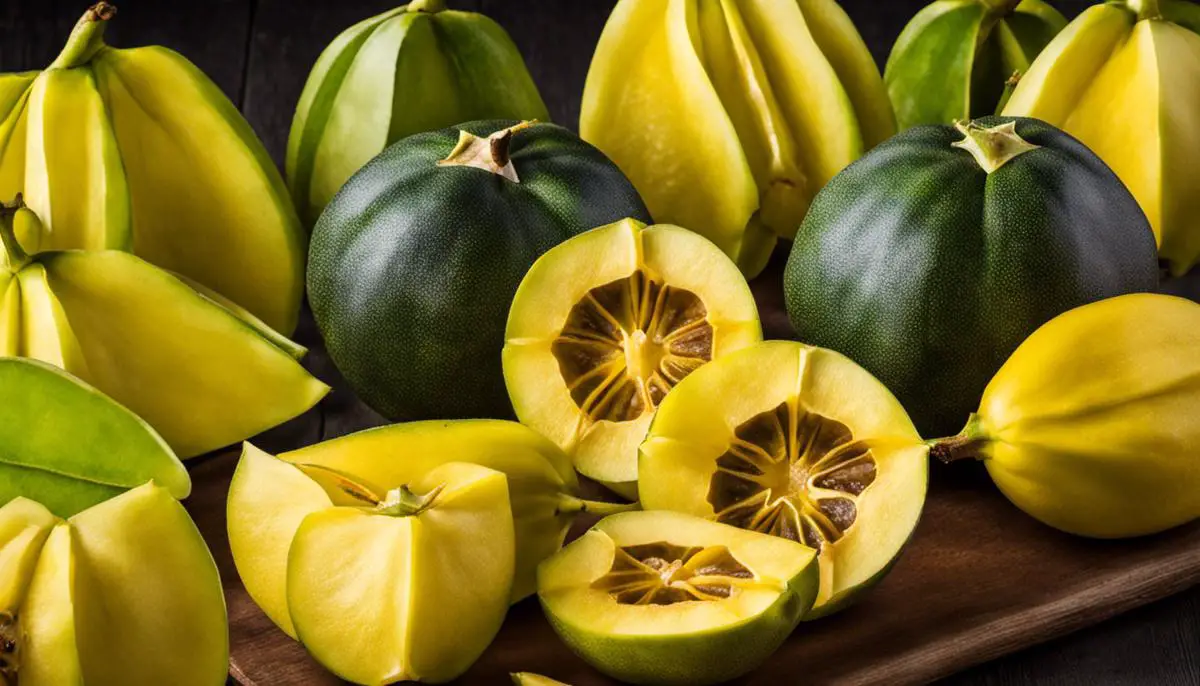Navigating the world of health and nutrition can often seem like a complex endeavor, especially when it comes to understanding conditions such as high blood pressure and decoding the potential benefits of unfamiliar fruits like the exotic star fruit. High blood pressure, a condition affecting millions globally, is often attributed to various lifestyle and genetic factors, but did you know that simple dietary changes might assist in managing it? One such change could involve the incorporation of star fruit – a nutrient-packed tropical fruit with several health benefits, including potential blood pressure management.
Understanding High Blood Pressure
Understanding High Blood Pressure
High blood pressure, also referred to as hypertension, is a severe health condition that happens when the force of blood against the artery walls is too high consistently. It is often dubbed the “silent killer” as it mostly doesn’t show visible symptoms and can silently damage your health over the years. High blood pressure can cause hardened arteries, decreased blood flow, and numerous subsequent health issues such as heart disease, stroke, kidney disease, or even heart failure.
Causes and Symptoms
High blood pressure can be attributed to numerous factors including older age, family history of the disease, a diet high in sodium, lack of physical activity, being overweight or obese, heavy drinking, high levels of stress, and certain chronic conditions. Notably, many people with high blood pressure do not experience symptoms until their blood pressure reaches dangerous levels. However, some individuals might experience symptoms such as headaches, shortness of breath, or nosebleeds, though these symptoms don’t occur until high blood pressure has reached a severe or life-threatening stage.
The Link between Star Fruit and High Blood Pressure
Star fruit, or carambola, is a sweet and sour fruit that has the shape of a star. This fruit is rich in antioxidants, potassium, and vitamin C, and low in sodium, sugar, and acid. The high potassium content in star fruit acts as a vasodilator, helping to keep your blood vessels relaxed, reducing the risk of high blood pressure. Potassium also assists in counteracting the effects of excessive sodium in the body, providing an indirect benefit to blood pressure levels.
Potential Risks with Star Fruit
However, those with high blood pressure, especially those with also kidney disease, need to be cautious when consuming star fruit. Despite its healthy properties, star fruit contains a neurotoxin. For people with healthy kidneys, this neurotoxin is easily filtered out of the body and doesn’t cause problems. However, for those with kidney problems, consuming star fruit can lead to star fruit intoxication as their kidneys cannot effectively filter out the neurotoxin. Symptoms of this can range from hiccups and vomiting to more severe symptoms such as seizures, mental confusion, and even death in severe cases.
Summary
Despite the many health benefits provided by star fruit, individuals suffering from high blood pressure or kidney conditions are advised to consult their healthcare provider prior to incorporating this fruit into their diet. The potential risks associated with consumption of star fruit, in some instances, may supersede its health benefits.

Star Fruit 101
Introduction to Star Fruit
The star fruit, formally known as carambola, hails from the tropical region of Southeast Asia. Named for its unique star-shaped cross-section when sliced, this exotic fruit, which offers an array of health benefits, has become increasingly popular across the globe. The fruit displays five lobes, and has a thin, waxy skin that turns from green to yellow as it ripens. The flesh of the fruit offers a juicy and crunchy texture with a taste that beautifully balances sweet and tart, often compared to the flavors of pineapples, lemons, and apples.
Nutritional Value of Star Fruit
Star fruit is a low-calorie, nutrient-rich fruit loaded with essential dietary fiber. It is packed with vitamin C, which boosts immunity, and vitamin A, important for maintaining eye health. The fruit is also a good source of several vital B-complex vitamins and essential minerals like potassium, phosphorus, zinc, and iron. Potassium, in particular, is a mineral that can help regulate heart rate and blood pressure.
Star Fruit and High Blood Pressure
High blood pressure, or hypertension, is a chronic condition that can lead to severe complications if not managed effectively. Lifestyle and dietary modifications are often recommended for controlling high blood pressure, and incorporating heart-healthy foods like star fruit can potentially be of great aid.
Star fruit contains a good amount of potassium, a vital mineral that plays a key role in maintaining heart health. Potassium is known to help balance out the negative effects of salt and regulate blood pressure by easing the tension in blood vessels and promoting vasodilation – a process in which blood vessels relax and widen, allowing blood to flow more freely and at a lower pressure.
However, patients with kidney problems or those on kidney dialysis should steer clear from star fruits. They are high in oxalates, which can be harmful for these individuals due to the reduced capabilities of their kidneys to filter out the excess. This might also lead to a dangerous buildup of potassium in their bodies, a condition known as hyperkalemia.
Exploring the Healthful Potential of Star Fruit
Notable for its intriguing star-like shape and unique refreshing taste, star fruit boasts a myriad health benefits. This fruit is a potent ally in promoting satiety and regulating digestion, thanks to its high fiber and water content. Its nutrient-rich profile, brimming with antioxidants, vitamins, and minerals, contributes to improved immunity and resistance against common ailments. Star fruit, also hailed for its vitamin A content, promotes the maintenance of healthy eyes and skin.
For these reasons, the inclusion of star fruit in a healthful, diverse diet could yield an array of health benefits. Nevertheless, those with kidney disorders should avoid star fruit due to its neurotoxin content that can prove harmful. As with any change in diet or the introduction of new foods, consulting a healthcare provider is suggested to ensure any new regimen aligns with individual health statuses and needs.

Star Fruit and Blood Pressure Management
Understanding Star Fruit’s Potential Benefits for Blood Pressure
Averrhoa carambola, better known as star fruit, offers potential benefits for individuals managing high blood pressure. What makes this tropical fruit beneficial is its high potassium content. This mineral is vital for curtailing blood pressure, according to the American Heart Association. Potassium works by minimising the impact of sodium and reducing blood vessel wall tension, thereby aiding blood pressure management.
Research studies, like one published in the Journal of Food Science and Technology, suggest that star fruit extracts could have a vasodilatory effect, amplifying the reduction in blood pressure. This effect is triggered by star fruit compounds that encourage blood vessels to widen. However, while initial research shows promise, more in-depth human trials are needed to confirm the definitive role of star fruit in managing high blood pressure.
Incorporating Star Fruit into a Diet
Due to its distinctive sweet and sour flavor, star fruit can be easily incorporated into various recipes, such as salads, smoothies, and desserts, or simply consumed as a fresh snack. As star fruit is low in calories but rich in fiber, vitamins, and antioxidants, it can contribute to a nutritious and balanced diet.
It is also important to note that while fresh star fruits are most nutritious, they are seasonal and may not be available in all regions throughout the year. Therefore, opting for dried or canned star fruit can be an alternative way to incorporate this fruit into your diet. However, keep in mind that process methods might increases sugar content, which can affect blood pressure levels.
Risks and Considerations
As beneficial as it can be, it is essential to approach the consumption of star fruit with care, especially for those with kidney problems. The fruit contains a neurotoxin that can affect the nervous system and cause serious symptoms, such as confusion and seizures, especially in individuals with kidney disease. This is because healthy kidneys are capable of filtering this toxin out, while unhealthy ones cannot. Therefore, those with such kidney concerns are advised against consuming star fruit.
Additionally, while star fruit is abundant in potassium, which is generally beneficial for those with high blood pressure, an excessive intake can also cause hyperkalemia – a condition characterized by too much potassium in the blood. This can lead to muscle weakness, heart palpitations and potentially, serious heart conditions in severe cases.
Given the above, it is important to consume star fruit – like any food – in moderation, and to consult with healthcare professionals, especially for those with underlying health conditions.

It’s clear that the journey to better health does not necessitate complex or radical changes but can be achieved through simple, consistent steps like incorporating nutritious fruits such as star fruit into our diet. While it’s important to consider professional medical advice before making any dietary alterations, especially if you have kidney problems, star fruit has shown potential in contributing to high blood pressure management. Armed with a better understanding of high blood pressure and the substantial nutritional benefits of star fruit, we can make more informed decisions to keep our hearts happy, our blood pressure in check, and ultimately lead healthier lives.
